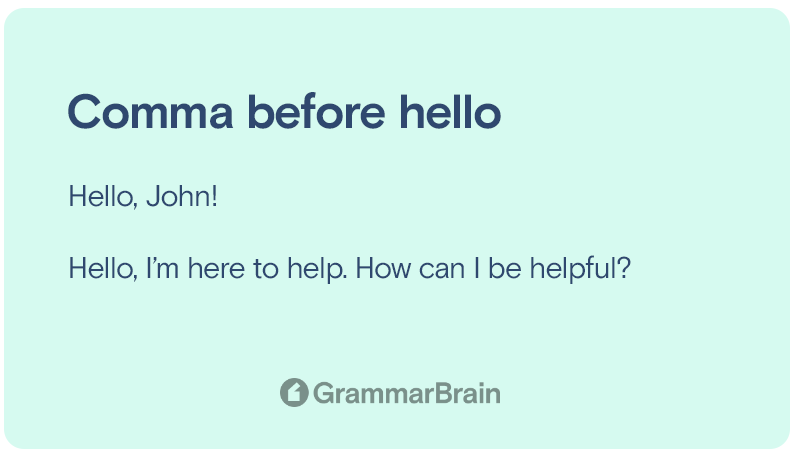Is there a comma after the word “hello?” For example, “Hello, I am here.” Are you responsible for sending emails and notifications to clients and others at your workplace? If yes, this article is for you. Having a grammatically correct email is important when it comes to business communication.
Do you use a comma after “hello” or “hi?”
The answer is simple, it’s up to you. Typically, we are looking to use “Hello” as a greeting or salutation. And to refer to either a group or non-gender-specific addressing. In that case, we can say “Hello,” with a comma.
You can also use “Hello, John.” This is where a vocative comma comes into practice. And is grammatically correct.

Addressing the addressee
Every written communication is typically addressed to someone. The person you address is the addressee. Frequently, we address the person by his or her name, for example:
- Hi, Bob
or
- Hello, Amanda
In the case of formal written communication, we can add Mr., Mrs, and Ms.
At times if not most, the addressee is not mentioned but implied. You may scroll up and see that this article is not addressed to anyone specific but to all (“Hello,”).
The comma after the word hello is to democratize the person you are addressing (addressing a unified group or not a specific person).
Salutations in emails and letters
Starting any communication with a salutation is an age-old practice of politeness that has thankfully continued. A salutation may consist of greetings and a noun, like:
- Hello, Cynthia
or an adjective and a noun, like:
- Dear Cynthia,
Please note that I have put a comma after the name in the above address. The use of this comma is optional. You’ll see them in letters more than in emails.
The vocative comma
Did you know there are eight different usages of commas? One of them is the vocative comma, and the comma we are discussing here is precisely the same. Now vocative commas can be used in three different ways:
- At the start
- Intermediate (the middle)
- And at the conclusion
Examples:
- For citations and salutations: “Hi Albert, hope you are doing fine.
- Intermediately: “Believe me, kid, when I say I have done this before.
In conclusion:
- “I hope you got my drift, Jennifer.”
Please note in the above sentences, the vocative comma is used to offset the subject of the direct address.
Comma or colon
We have also seen the practice of putting a colon in formal business letters and emails:
- Dear, Mr. Smith:
We used them in formal business letters, and the colon conveyed a certain reverence towards the addressee. A point to be noted here is though an ancient practice, it will not be an impropriety to use it.
With the business environment becoming more casual than official, the comma now plays a much more significant function.
Find out more about open and closed punctuation marks in business letters and emails from this resource.
Traditional vs. essential
As we can see, the comma after a direct address is critical:
- Dear, Camilla
The comma after greetings is also critical:
- Hi Camilla, it is not always innate to communicate.
The tone of your communication (formal vs. informal) defines if and where you should place the comma.
For example:
- On a scale of 1 to 10 (where 1 is the lowest and 10 is the highest)
- While addressing your parents, the level of formality is, let’s say, 1.
- While addressing your friends and family could be 1.5
- While addressing your co-workers, could be 3
- While addressing your boss or business partner may be more than 5.
Inside this article
Fact checked:
Content is rigorously reviewed by a team of qualified and experienced fact checkers. Fact checkers review articles for factual accuracy, relevance, and timeliness. Learn more.
Core lessons
Glossary
- Abstract Noun
- Accusative Case
- Anecdote
- Antonym
- Active Sentence
- Adverb
- Adjective
- Allegory
- Alliteration
- Adjective Clause
- Adjective Phrase
- Ampersand
- Anastrophe
- Adverbial Clause
- Appositive Phrase
- Clause
- Compound Adjective
- Complex Sentence
- Compound Words
- Compound Predicate
- Common Noun
- Comparative Adjective
- Comparative and Superlative
- Compound Noun
- Compound Subject
- Compound Sentence
- Copular Verb
- Collective Noun
- Colloquialism
- Conciseness
- Consonance
- Conditional
- Concrete Noun
- Conjunction
- Conjugation
- Conditional Sentence
- Comma Splice
- Correlative Conjunction
- Coordinating Conjunction
- Coordinate Adjective
- Cumulative Adjective
- Dative Case
- Determiner
- Declarative Sentence
- Declarative Statement
- Direct Object Pronoun
- Direct Object
- Diction
- Diphthong
- Dangling Modifier
- Demonstrative Pronoun
- Demonstrative Adjective
- Direct Characterization
- Definite Article
- Doublespeak
- False Dilemma Fallacy
- Future Perfect Progressive
- Future Simple
- Future Perfect Continuous
- Future Perfect
- First Conditional
- Irregular Adjective
- Irregular Verb
- Imperative Sentence
- Indefinite Article
- Intransitive Verb
- Introductory Phrase
- Indefinite Pronoun
- Indirect Characterization
- Interrogative Sentence
- Intensive Pronoun
- Inanimate Object
- Indefinite Tense
- Infinitive Phrase
- Interjection
- Intensifier
- Infinitive
- Indicative Mood
- Participle
- Parallelism
- Prepositional Phrase
- Past Simple Tense
- Past Continuous Tense
- Past Perfect Tense
- Past Progressive Tense
- Present Simple Tense
- Present Perfect Tense
- Personal Pronoun
- Personification
- Persuasive Writing
- Parallel Structure
- Phrasal Verb
- Predicate Adjective
- Predicate Nominative
- Phonetic Language
- Plural Noun
- Punctuation
- Punctuation Marks
- Preposition
- Preposition of Place
- Parts of Speech
- Possessive Adjective
- Possessive Determiner
- Possessive Case
- Possessive Noun
- Proper Adjective
- Proper Noun
- Present Participle
- Prefix
- Predicate



